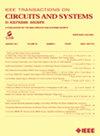UniPRE:具有统一最大池预测和冗余消除的SNN-ANN加速器
IF 4.9
2区 工程技术
Q2 ENGINEERING, ELECTRICAL & ELECTRONIC
IEEE Transactions on Circuits and Systems II: Express Briefs
Pub Date : 2025-06-23
DOI:10.1109/TCSII.2025.3582265
引用次数: 0
摘要
由于脉冲神经网络(SNNs)和人工神经网络(ann)具有高能效和准确性的潜力,因此在特定任务中集成它们引起了相当大的兴趣。在SNN-ANN融合硬件中,许多工作集中在算子的神经元级融合上。尽管有些人已经探索了数据流级别的优化,但它们仅限于一种网络。本文简要介绍了一种数据底层的统一预测方法,通过利用通道重要性(CI)来消除SNN和ANN的最大池化操作所产生的冗余计算。为了支持这种优化,还提出了一个在线排序通道重要性(CI)的加速器,称为UniPRE。结果表明,UniPRE在SNN和ANN使用37.5%信道进行预测的情况下,总体计算量分别减少44.77%和31.85%,精度损失可以忽略不计。UniPRE采用标准28纳米CMOS技术实现,在8位权重精度的SNN和ANN模式下,能效分别达到19.32 GSOPS/ W和4.26 TOPS/W,面积效率分别为370.10 GSOPS/mm2和92.52 GOPS/mm2。在真实网络的分层评估中,使用25%的通道进行预测,可实现高达1.79倍的能量降低。本文章由计算机程序翻译,如有差异,请以英文原文为准。
UniPRE: An SNN-ANN Accelerator With Unified Max-Pooling Prediction and Redundancy Elimination
The integration of Spiking Neural Networks (SNNs) and Artificial Neural Networks (ANNs) for specific tasks has attracted considerable interest due to their potential for high energy efficiency and accuracy. In SNN-ANN fused hardware, many works focus on neuron-level fusion of operators. Though some have explored optimizations at the dataflow level, they are restricted to only one kind of networks. This brief introduces a dataflow-level unified predicting method to eliminate redundant computations resulted from max-pooling operations for both SNN and ANN by exploiting Channel-wise Importance (CI). An accelerator with online sorting of Channel-wise Importance (CI) to support this optimization is also proposed, named as UniPRE. Results show that UniPRE reduces 44.77% and 31.85% overall computations with negligible accuracy loss for SNN and ANN using 37.5% channels for prediction. Implemented in the standard 28-nm CMOS technology, UniPRE can reach an energy efficiency of 19.32 TSOPS/W and 4.26 TOPS/W, with an area efficiency of 370.10 GSOPS/mm2 and 92.52 GOPS/mm2 for SNN and ANN paradigms of 8-bit weight precision, respectively. In layer-wise evaluation of real networks, up to $1.79\times $ energy reduction is achieved with 25% channels used for prediction.
求助全文
通过发布文献求助,成功后即可免费获取论文全文。
去求助
来源期刊
CiteScore
7.90
自引率
20.50%
发文量
883
审稿时长
3.0 months
期刊介绍:
TCAS II publishes brief papers in the field specified by the theory, analysis, design, and practical implementations of circuits, and the application of circuit techniques to systems and to signal processing. Included is the whole spectrum from basic scientific theory to industrial applications. The field of interest covered includes:
Circuits: Analog, Digital and Mixed Signal Circuits and Systems
Nonlinear Circuits and Systems, Integrated Sensors, MEMS and Systems on Chip, Nanoscale Circuits and Systems, Optoelectronic
Circuits and Systems, Power Electronics and Systems
Software for Analog-and-Logic Circuits and Systems
Control aspects of Circuits and Systems.

 求助内容:
求助内容: 应助结果提醒方式:
应助结果提醒方式:


